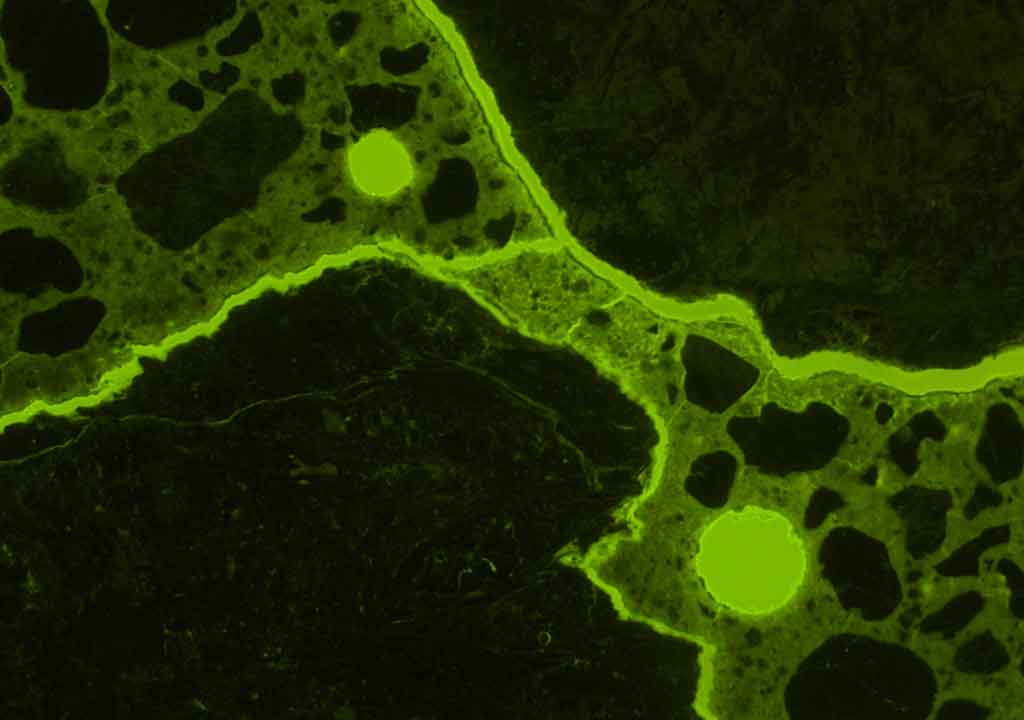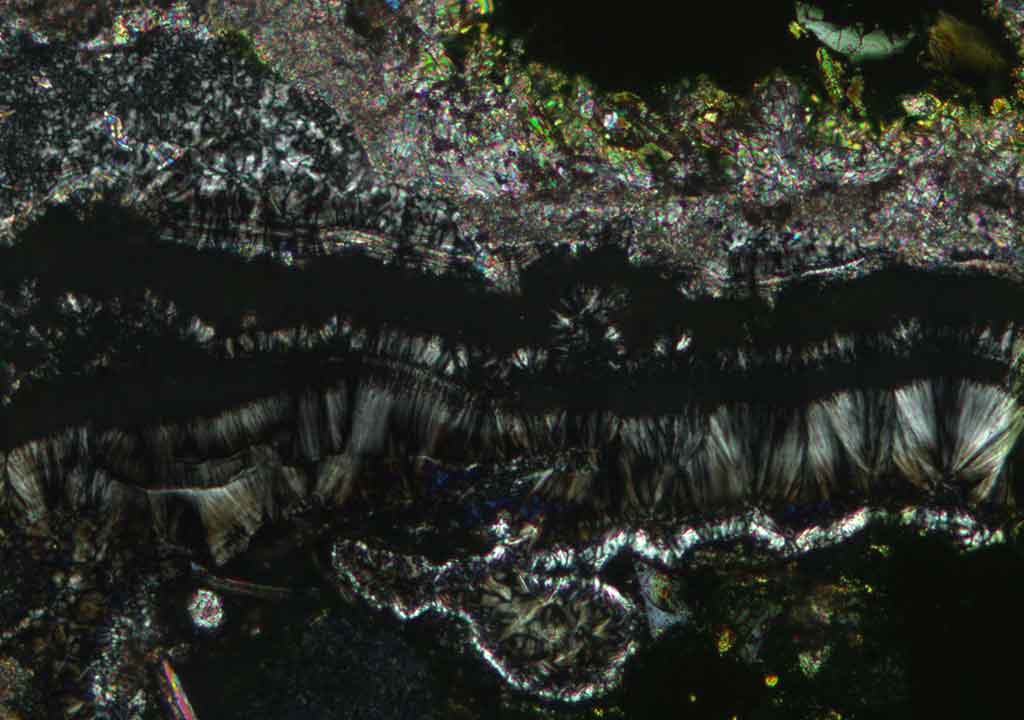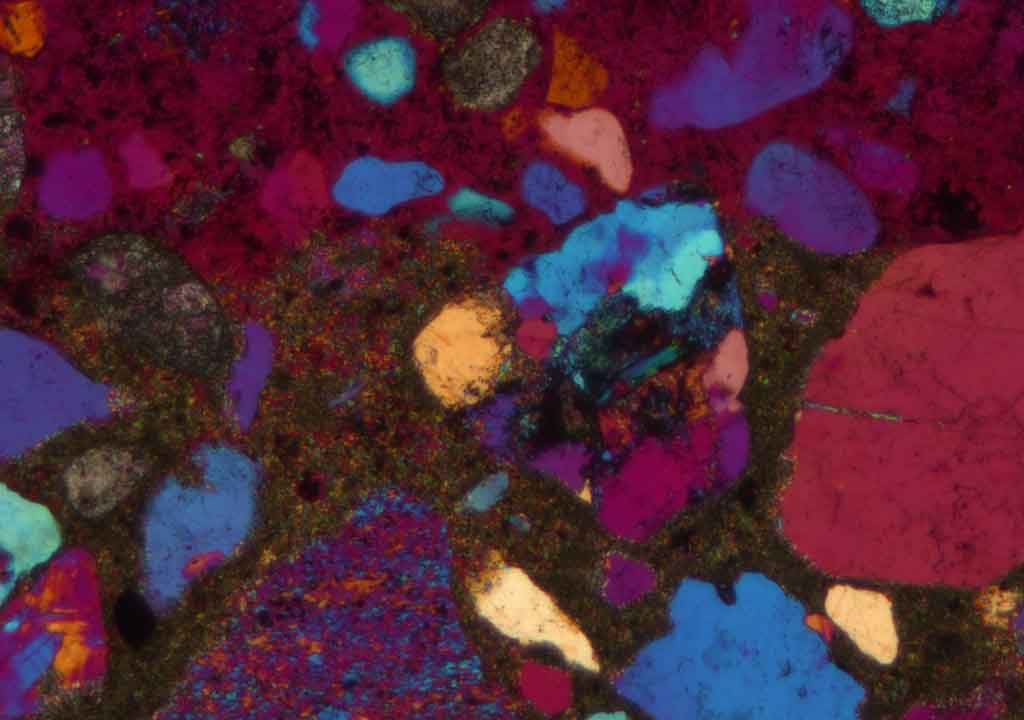Freeze – Thaw Deterioration of Concrete
Concrete Experts International has extensive knowledge in theory and diagnosis of concrete deteriorated by freeze thaw actions (F/T). Diagnosing deterioration from freeze thaw action is an integrated part of our petrographic analysis of concrete.
Freeze – Thaw Deterioration of Concrete
Concrete Experts International has extensive knowledge in theory and diagnosis of concrete deteriorated by freeze thaw actions (F/T). Diagnosing deterioration from freeze thaw action is an integrated part of our petrographic analysis of concrete.
Why may concrete deteriorate from freeze thaw actions?
Deterioration of concrete from freeze thaw actions may occur when the concrete is critically saturated, which is when approximately 91% of its pores are filled with water. When water freezes to ice it occupies 9% more volume than that of water. If there is no space for this volume expansion in a porous, water containing material like concrete, freezing may cause distress in the concrete. Distress to critically saturated concrete from freezing and thawing will commence with the first freeze-thaw cycle and will continue throughout successive winter seasons resulting in repeated loss of concrete surface. It is described very well in this video from one of our clients >
To protect concrete from freeze/thaw damage, it should be air-entrained by adding a surface active agent to the concrete mixture. This creates a large number of closely spaced, small air bubbles in the hardened concrete. The air bubbles relieve the pressure build-up caused by ice formation by acting as expansion chambers. About 4% air by volume is needed and the air-bubbles should be well distributed and have a distance between each other of less than 0.25 mm in the cement paste.
Concrete with high water content and high water to cement ratio is less frost resistant than concrete with lower water content.
Macro- & microscopic appearance
Deterioration of concrete by freeze thaw actions may be difficult to diagnose as other types of deterioration mechanisms such as ASR often go hand in hand with F/T. Often is may be difficult to evaluate which mechanism caused the initial damage, however, if all other mechanisms can be excluded the typical signs of F/T are:
- Spalling and scaling of the surface
- Large chunks (cm size) are coming of
- Exposing of aggregate
- Usually exposed aggregate are un-cracked
- Surface parallel cracking
- Gaps around aggregate – in the ideal case
- The air void system of hardened concrete can be tested using the RapidAir system >
Please do not hesitate to contact CXI if you have some problems regarding freeze thaw deterioration of concrete or any other deterioration mechanisms.
Terms and definitions
Using the same terms makes communication better! We have made this small dictionary which describes some of the terms used in concrete examination and description.
Terms and Definitions
The following small dictionary describes some of the terms used in concrete examination and description.
Agglomerate: 3 or more air voids in close contact
Aggregate: Component of the concrete consisting of a coarse aggregate fraction (more than 4 mm) and a fine aggregate fraction (less than 4 mm)
Alite: Tricalciumsilicate, C3S (3CaO-SiO2), a natural occurring mineral present in ordinary Portland cement.
Alkali silica reaction: Reaction between silica in the aggregates (e.g. chert, flint, micro-crystalline quartz), alkali (from cement, de-icing salt, sea water), calcium hydroxide and water. Alkali silica reaction causes aggregates to expand and cracks are formed radiating out into the ambient cement paste.
Alkali silica gel: A product of alkali silica reaction. Gel is usually clear, transparent and non-crystalline (amorphous), although in some cases it may crystallize. It expands during water absorption. Gel is usually found lining or filling cracks and air voids.
Aluminate phase: Tricalciumaluminate, C3A (3CaO-Al2O3)
Anhydrate: CaSO4
Belite: Dicalciumsilicate, C2S (2CaO-SiO2), natural occurring mineral present in ordinary Portland cement.
Bleeding: Water separation in the concrete. "Bleeding" is the phenomenon where water migrates towards the surface of the concrete and collects on the surface or underneath coarse aggregates. Seen as narrow voids along the interface between aggregate and cement paste. Calcium hydroxide may be deposited in the voids.
Calcium carbonate: CaCO3 , calcite, found as deposits in voids and cracks and on the surface.
Calcium hydroxide: Ca(OH)2, Portlandite, hydration product of C3S and C2S. Appears throughout the non-carbonated cement paste and occasionally as larger crystals in voids and cracks
Carbonation: Transformation of the calcium containing constituents of the concrete by reaction with the carbon dioxide in air. Calcium hydroxide is transformed to calcium carbonate and consequently the paste becomes chemically neutral.
Cement: The visible cement minerals are: C3S, C2S and C4AF. C3A is not visible.
Cement paste: Compound of hydration products from the cement-water reaction and unhydrated cement. Micro silica (MS) and fly ash (FA) is usually treated as part of the paste.
Cracks: Are divided in 3 groups in relation their width: coarse cracks are cracks wider than 0.1 mm, fine cracks varies from 0.01 - 0.1 mm and micro cracks are less than 0.01 mm. Cracks usually run in the cement paste; however, occasionally the aggregates are traversed. Cracks form either in the early (plastic stage) or at a later stage (fully hardened stage) in the life of the concrete .
Delayed Ettringite Formation (DEF): Hardened concrete that has been subjected to high-temperature heat curing or high internal hydration heat temperature may suffer from expansion and cracking during subsequent exposure to moisture. DEF is diagnosed by the presence of gaps around aggregate particles.
Entrained air: Usually defined as the small and medium sized spherical air voids with maximum size 0.5 - 1 mm
Entrapped air: Comprises irregular and angular air voids of all sizes
Ettringite: 3CaO.Al2O3.3CaSO4.32H2O. Needle shaped crystals of calcium sulfo-aluminate hydrate produced by constituents in the cement paste, including gypsum. It is also produced by sulfate attack on the concrete.
Ferrite phase: Tetracalciumaluminateferrite, C4AF (4CaO-Al2O3-Fe2O3)
Filled voids: Air voids with complete or partial filling of e.g. alkali silica gel, ettringite, calcium hydroxide, calcium carbonate or gypsum.
Friedel Salt (mono-chloride): 3CaO.Al2O3.CaCl2.10H2O
Gaps: Cracks observed all the way around aggregate particles in the interface zone between aggregate and cement paste. Gaps can be empty, or be partly or completely filled with ettringite. The width of the gaps is positively correlated with the size of the aggregate. Gaps are evidence of some sort of paste expansion occurring from delayed ettringite formation (DEF), freeze/thaw and sulfate attack.
Gypsum: CaSO4.2H2O, calcium sulfate which is found as a common constituent of cement. It is also produced by acid attack (sulfuric acid) on concrete.
Hydration: Reaction between cement and water, producing cement gel (cement paste, cement glue) serving as an adhesive in the concrete.
Mono-sulfate: 3CaO.Al2O3.CaSO4.12H2O
Plastic shrinkage: Shrinkage caused by strong drying of newly cast concrete. The result is often plastic shrinkage cracks in the concrete surface.
Plastic settlement: Settlement of fresh concrete, often causing plastic settlement cracks.
Re-crystallization: Dissolution of crystals and re-deposition either of the same mineral in a different form or of new minerals, mostly stabilized due to the presence of water.
Segregation: "Segregation" is the phenomenon where the concrete has no internal adhesion, and the mortar (therefore separates from the coarse aggregates.
Thaumasite: CaSiO3.CaSO4.CaCO3. A mineral not naturally present in concrete. Thaumasite may occur in concrete suffering from sulfate attack. The presence of thaumasite depends according to literature on temperature and presence of carbon dioxide.
w/c ratio: The ratio of water to cement by weight of the cement paste. If the cement paste contains fly ash (FA) or micro silica (MS) the addition of these materials can be taken into account using an activity factor and an equivalent w/c ratio can be calculated.
Other Deterioration Mechanisms
Contact Us
Concrete Experts International ApS
Gøngehusvej 242
DK-2950 Vedbæk





